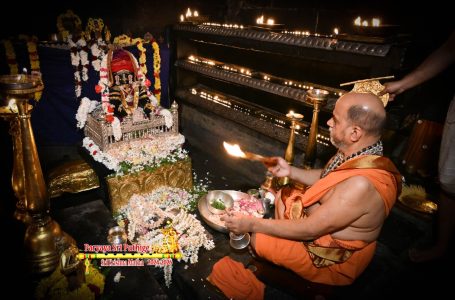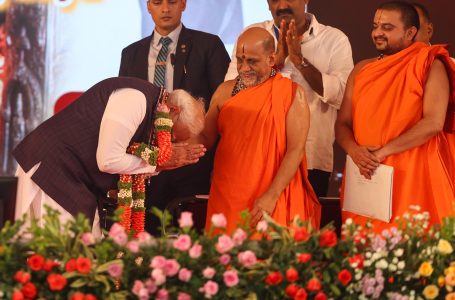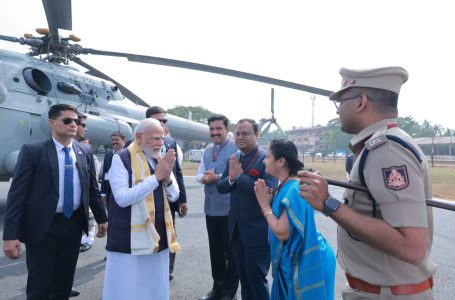A disciple’s tribute to Bannanje Govindacharya
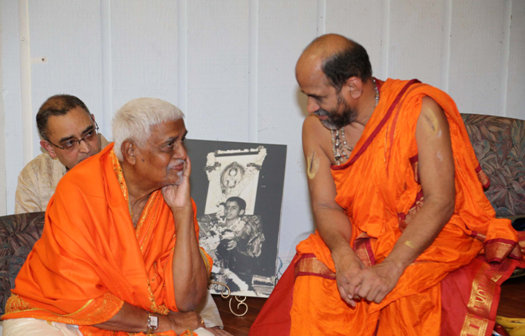
I have grown listening to Bannanje Govindacharya’s discourses. From my childhood, I would simply listen to his talks as he would place something new from the old texts which we otherwise would have left as boring.
His revolutionary thinking and oratory was always an attraction. In recent days when I am not able to physically attend his discourses, YouTube has come as a great help as all his present and also old Pravachana’s are available.
I am neither a Sanskrit Scholar not a close associate of Bannanje. Senior journalists and scholars may have many memorable things to place about him. This is my small effort to bring details about Bannanje. A small tribute by one among lakhs of his followers. Bannanje Govindacharya, we will miss you.
More than offering prayers to him and giving long speeches, the real homage would be by following what Bannanje said- question before blindly following anything, go to the roots of a subject, and find the answer to any question within you and not outside.
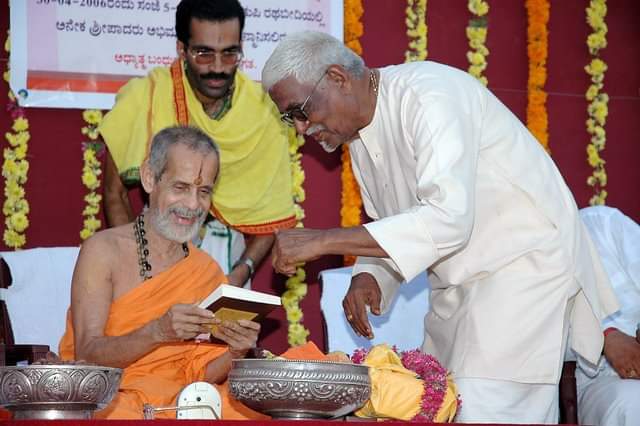
Udupi, Dec 13, 2020: He was neither a Matadhipathi nor head of any religious institution. But his followers believe him nothing less than that. Like Baji Rao was the flag bearer of Maratha Samrajya spreading the message of Shivaji Maharaj, Bannanje Govindacharya played an active role in spreading Madhvacharya’s philosophy throughout the world.
‘Jayati Parashara Soonuhu….. Pranatavan Praninam Pranabhootam Pranatibhih Poornaye Poornaodham…‘ listening to these shlokas would make thousands of devotees around the globe alert as they were the indication of Bannaje Govindacharya’s discourse.
His discourse started with these Shlokas offering prayers to Lord Vedavyasa and Sri Madhvacharya.
Bannanje’s death on Sunday came as a shock to his disciples for whom there were no words to express their grief.
Also read: Bannanje Govindacharya no more
Born in a traditional Madhva Shivalli family, religious texts were nothing new. His father was a great scholar and used to teach the Matadhipathis of Asta Matha. Bannanje began learning Sanskrit and philosophy at an early age and became well versed in them.
As a young boy, Govinda had doubts and place them before his father. One of the major turning points of his life was when his father asked him to search for the answer within.
This helped to turn Govinda into Govindacharya and later Padma Shri Vidyavachaspati Bannanje Govindacharya.
Bannanje’s style: The Goatee beard, T-Shirt, a cropped haircut, and fluency in English. Professionally he was a journalist with over 30 years in Udayavani. If this was the modern outlook, Bannanje’s knowledge was unparallel one. He was second to none in Madhwa tradition.

A revolutionary scholar:
In simple words, Bannanje can be defined as a revolutionary scholar.
While most of the orthodox scholars suggest people follow the tradition without questioning, for Bannanje questioning was everything.
“Our scriptures and tradition are very particular about doing things by knowing them. Following anything blindly is unacceptable,” Bannanje would tell his disciples.
Bannanje had an explanation for every question related to scriptures or tradition. Many a time he strongly opposed many of the ‘traditions.
While many orthodox believe that women and non-Brahmins should not chant mantras or shlokas like Vishnusahasranama or worship Saligrama, Bannanje stood strongly in their support.
He suggested women recite all shlokas and mantras. He also would tell that caste did not come by birth but by virtue.
Whenever people were scared to follow his revolutionary ideas fearing diversion from tradition, Bannanje would tell- “I have suggested you this as scriptures are clear about it. You need not fear any ‘Paapa.’ If there are any then it will not affect you. I will bear it all.”
His definition of ‘Madi,’ was also different from orthodox thinking. ‘Madi,’ is nothing but maintaining the cleanliness of mind. Cleanliness of the body is a step to achieve Madi. Mere cleaning the body and not touching others without having good thoughts during Pooja is not Madi, he felt.
Go to the roots:
Probably Bannanje was the only scholar in the modern times who had gone through all the manuscripts of all the Mathas in Udupi. Speak of any manuscript, Bannaje would tell where is it kept and what it really says. Thus he was an encyclopedia of Madhva manuscripts.
He also has the distinction of working on the ‘Sarva Moola Grantha,’ of Sri Madhwacharya penned down by his disciple Hrishikesha Teertha of Palimaru Matha. This is the only detailed manuscript available today of Madhvacharya written by his direct disciple.
While the manuscript is offered prayers at Palimaru Hrishikesha Matha the only time when it went out of the Matha was when Bannanje took it for translation.
Bannanje’s simple mantra was to refer to the original text of any book.
For Acharya, the entire Indian philosophy stood on numerology and psychology. Acharya would give a clear picture of this.
While Sanskrit words had various meanings for the same word, Bannanje would place not just the common meanings but also the traditional unnoticed meanings. For example for many ‘Varaha,’ means the Wild Boar avatar of Sri Vishnu. But Bannanje reveals that Varaha in traditional language means ‘Cloud,’ which hardly many know.
Clear on his stand on controversies:
He has argued even with Matadhipathis when it came to tradition and facts. He has strongly opposed the modernization of Sri Krishna Matha like putting up granite or marble stones.
When one of the seers of Asta Mathas wanted to put white marble and discussed it with Bannanje, the latter had objected to it.
The seer tried to pacify Bannanje saying that while was ‘satvika,’ color and black denoted ‘tamasa,’ color. Bannanje, known for his witty thinking quickly suggested- ‘then perhaps we can immerse the Krishna idol back to the sea and install a white marble idol inside…’
When it came to the Sri Krishna Janmashtami celebration too, Bannanje was very clear about the celebration.
It was clear that a tithi is decided during Suryodaya (Sun Rise). Sri Krishna Janmashtami falls on the day when the sun rises with Ashtami tithi. He had strongly opposed many Swamijis including Sri Vishwesha Teertha Sripadaru of Pejawara Matha on this issue.
Bannanje also differed on going abroad and not teaching the Madhva Tatva to foreigners and other castes. He strongly believed that the Madhva Tatva has to be taught everywhere, even abroad. So he was a supporter of Puthige Swamiji going abroad to spread Madhwa philosophy.
He also believed that Madhva philosophy has to be taught to all the caste and there should not be any discretion as Madhvacharya did not discriminate in the name of caste.
One of the pain which Bannanje had was the negligence of Indian’s shown towards the culture. “Perhaps the people and interest by foreigners.
Bannaje and Madhvacharya:
Bannanje stressed the strength of Mukhyaprana and had great respect for Sri Madhwacharya. He spoke and revered Madhvacharya.
“Whenever I had any questions related to any issue or any script, I placed it before Acharya (Madhvacharya) and he would give a reply to me,” Govindacharya would tell.
Bannanje would turn emotional during discourse especially when he spoke about the simplicity and lover towards devotees of Sri Krishna and the works of Acharya Madhva.
Bannanje also had great respect for the direct disciples of Sri Madhvacharya especially Trivikrama Panditacharya and Narayana Panditacharya.
Bannanje’s followers:
Bannanje had a great fan following right from Udupi to the United States. Several scholars from other countries too have stayed at his house for months to learn Sanskrit works. His Pravachana was a great crowd puller.
Bannanje’s authority over the subject, strength over the language and oratory attracted people. Even those who opposed the Madhva philosophy too agreed with his authority over the subject.
Bannanje’s followers worshipped him nothing less than Madhava Peetadhipathis. One of the viral videos on social media shows a disciple offering Pada Puja to Bannanje when she met him at an airport!
Books and articles:
When it comes to books, our memory falls shorts to count.
Bannanje has touched all types of books right from Bhagavadgeethe to Vatsayana’s Kamasutra. His typical translations attracted scholars as he would place a proper alternative word during translation.
Asta Matha and Bannanje:
The seers of Madhva Mathas had great respect towards Bannanje Govindacharya. Recently when Sri Vidyadheesha Teertha Sripadaru of Palimaru Matha gave Deeksha to Vidya Rajeshwara Teertha, he had asked the latter to meet Bannanje before becoming the Matadhipathi.
For any confusion related to scriptures or traditions, the Swamijis and scholars would contact Bannanje.
But Bannanje would never turn silent whenever he felt any stand of Mathas were wrong.
He would directly tell them his objection and also the reason for it. There has been no incident where the Swamijis have opposed him as they knew that he was the authority on Madhva tradition.
- G R Rao, a resident of Udupi, as told to The Canara Post


